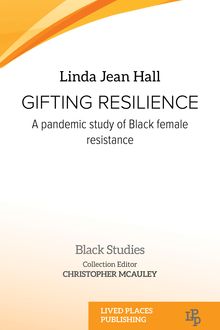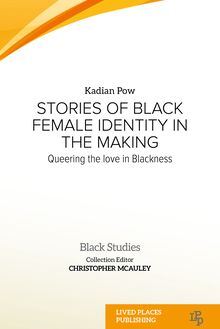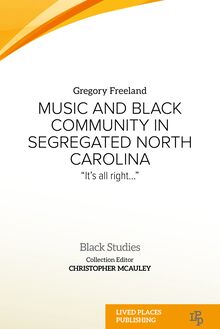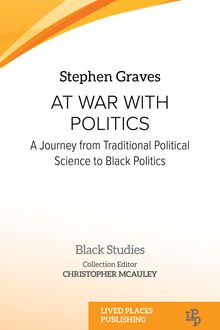-
 Univers
Univers
-
 Ebooks
Ebooks
-
 Livres audio
Livres audio
-
 Presse
Presse
-
 Podcasts
Podcasts
-
 BD
BD
-
 Documents
Documents
-
- Cours
- Révisions
- Ressources pédagogiques
- Sciences de l’éducation
- Manuels scolaires
- Langues
- Travaux de classe
- Annales de BEP
- Etudes supérieures
- Maternelle et primaire
- Fiches de lecture
- Orientation scolaire
- Méthodologie
- Corrigés de devoir
- Annales d’examens et concours
- Annales du bac
- Annales du brevet
- Rapports de stage
La lecture à portée de main
Vous pourrez modifier la taille du texte de cet ouvrage
Découvre YouScribe en t'inscrivant gratuitement
Je m'inscrisMusic and Black Community in Segregated North Carolina , livre ebook
Découvre YouScribe en t'inscrivant gratuitement
Je m'inscrisEn savoir plus
Vous pourrez modifier la taille du texte de cet ouvrage
En savoir plus

Description
Emotional courage is an underestimated characteristic of successful Black life in the segregated, unjust US south. Author Greg Freeland reflects on how music reflected, impacted, and influenced Black life in 1950s and 1960s North Carolina.
The celebratory aspect of the Black rhythm and blues, jazz, and gospel music of Freeland’s life is one of his clearest memories of the time. In this book, he recalls and reflects upon how music was integral to the solidary and resilience of his Black community in an unequal and unjust society. Through examples of music in the household, church, clubs, parties, and schools, this book explores how music worked in a manner that facilitated the development, mobilization, and realization of Black life.
Learning objectives
Introduction
1: Music and community
2: Durham, North Carolina
3: Musics in Durham, from rhythm and blues to gospel
4: The church and gospel music
5: Intersection of music and everyday life in segregated society
6: Music in the Civil Rights Movement
7: Hayti, the Black Wall Street
8: Dining in Durham
9: Roots in slavery
10: Women in Hickstown; women in North Carolina; women in the struggle
11: A Change is Going to Come
12: Reflections on music and dance
13: Radio and WLAC
14: Music as a Transcendant Force
15: School days
16: Segregation in; segregation out
17: Sam Cooke takes it to another level
18: Improvisational survival
19: The music encompasses the struggle
20: Back to the Movement and out
Conclusion
Activities and learning objectives
Sujets
Musique
Histoire de la musique
Ethnic Studies
Black Studies
20th Century
Social Science
Subjects
Teaching
HISTORY
EDUCATION
Sociologie, société et politique
MUSIC
Años 1950
Carolina del Norte
América
Jim Crow laws
Multiple signal classification
African American culture
African-American history
Anti-racism
History of classical music traditions
Ethnomusicology
History of the United States
Subject
1950s
Social sciences
North Carolina
History of the Americas
African American
Anthropology
American
United States
FL
Jim Crow
KY
LA
TN
MS
SC
NC
AR
Discrimination
VA
GA
Caroline du Nord
Informations
| Publié par | Lived Places Publishing |
| Date de parution | 22 mai 2023 |
| Nombre de lectures | 2 |
| EAN13 | 9781915271228 |
| Langue | English |
Informations légales : prix de location à la page 0,1250€. Cette information est donnée uniquement à titre indicatif conformément à la législation en vigueur.
Extrait
Music and Black community in segregated North Carolina
Dr Gregory Freeland, PhD
Music and Black community in segregated North Carolina
The Black Studies Collection
Collection editor
Dr Chris McAuley
First published in 2023 by Lived Places Publishing
All rights reserved. No part of this publication may be reproduced, stored in a retrieval system, or transmitted in any form or by any means, electronic, mechanical, photocopying, recording or otherwise, without prior permission in writing from the publisher.
The authors and editors have made every effort to ensure the accuracy of information contained in this publication, but assume no responsibility for any errors, inaccuracies, inconsistencies and omissions. Likewise, every effort has been made to contact copyright holders. If any copyright material has been reproduced unwittingly and without permission the Publisher will gladly receive information enabling them to rectify any error or omission in subsequent editions.
Copyright © 2023 Lived Places Publishing
British Library Cataloguing in Publication Data
A CIP record for this book is available from the British Library
ISBN: 9781915271211 (pbk)
ISBN: 9781915271235 (ePDF)
ISBN: 9781915271228 (ePUB)
The right of Gregory Freeland to be identified as the Author of this work has been asserted by them in accordance with the Copyright, Design and Patents Act 1988.
Cover design by Fiachra McCarthy
Book design by Rachel Trolove of Twin Trail Design
Typeset by Newgen Publishing UK
Lived Places Publishing
Long Island
New York 11789
www.livedplacespublishing.com
Abstract
This book discusses how music created and maintained community strength and solidarity during legalized segregation in Durham, North Carolina. Music, with its rhythms, repetitive phrases, and lyrics, gave Black community members survival strength and symbolic images rooted in traditional spirituals, jazz, rhythm and blues, and gospel music. These diverse musical forms evolved and interacted in relation to the complex ideological, historical, and economic forces that formed Black communities, like Hickstown, in West Durham. By examining and reflecting on segregation between 1957 and 1963 in North Carolina and the parallel musical forces, this book finds that the complex interrelationship between music and the Black community both inspired and responded to the Black peoples’ survival and collective experience. Memories of segregation are replete with moments in which the power of music provided courage, inspiration, and unity.
Keywords
American history; jazz; rhythm blues; autobiography; 1950s; southern United States; segregation; Jim Crow; African American culture; community; hidden transcripts, call and response; Hayti; Sam Cooke; WLAR; Rhythm and Blues; integration; Black Wall Street; Black religion; 1963; Crest Street; music of Black origin
Contents
Learning objectives ix
Introduction 1
Chapter 1 Music and community 3
Chapter 2 Durham, North Carolina 9
Chapter 3 Musics in Durham: from rhythm and blues to gospel 19
Chapter 4 The church and gospel music 35
Chapter 5 Intersection of music and everyday life in segregated society 53
Chapter 6 Music in the Civil Rights Movement 63
Chapter 7 Hayti: the Black Wall Street 75
Chapter 8 Dining in Durham 89
Chapter 9 Roots in slavery 97
Chapter 10 Women in Hickstown; women in North Carolina; women in the struggle 105
Chapter 11 A change is going to come 111
Chapter 12 Reflections on music and dance 121
Chapter 13 Radio and WLAC 133
Chapter 14 Music as a transcendent force 147
Chapter 15 School days 165
Chapter 16 Segregation in; segregation out 171
Chapter 17 Sam Cooke takes it to another level 177
Chapter 18 Improvisational survival 191
Chapter 19 The music encompasses the struggle 201
Chapter 20 Back to the Movement and out 211
Conclusion 219
Activities and learning objectives 225
Bibliography 237
Index 247
Learning objectives
1. Students will develop the ability to carry out interdisciplinary study in Black civil rights that is informed by theories and practices of Black life and survival from slavery to the Civil Rights Movement.
2. Students will develop an understanding of the relational nature of music and Black struggles for equality and justice.
3. Students will develop an understanding of the ongoing changes associated with contemporary racial relations as products of historical processes.
4. Students will understand how Black people’s struggles for equality and justice reconstitute configurations of community unity to their advantage.
5. Students will develop the ability to interrogate the dominant political and cultural categories used to frame survival processes.
6. Students will learn how to identify the larger system in which they are rooted, utilizing critical theoretical and methodological approaches from Black people’s struggles, like nonviolence, music, religion, and social networks.
Introduction
It’s Saturday night, around midnight, at the Square Club . You hear rhythmically vibrating rhythm and blues (RnB ), generating a celebratory atmosphere for the crowd of Black folks who enjoy a release from everyday stress, caused by the social, economic, religious, and political problems in Durham, North Carolina. Heat from the summer night and the closely packed dancing bodies do little to dampen the stylish clothes and hairdos of the dancer s, moving in rhythm to vibrations created by Durham’s top-notch Black musicians. This was where it was at. You got there, whether you drove, walked, or rode in an automobile, from the top-tier Cadillac right on down to the most unreliable banger. The temperature in the club matched the energy of the people, the driving of the musicians, and the atmosphere of the sultry humid summer nights; nights made for good feelings and the unconscious strengthening of community.
This scenario, played out time and again, is part of the foundation of my exploration of music and the emotional, communal, and celebratory effect that it had on a Black community in Durham. It mirrors numerous stories and similar scenarios that took place throughout southern Black communities, but this emphasis is on a small Durham community called Hickstown in the late 1950s, and what it was like for me living there during that time when the United States was on the verge of rescinding segregationist laws, practiced in the South—an event that for me and my community was celebratory in itself.
For people who are living in situations where injustice and inequalities are on display on a daily basis, emotional courage is the tie that binds. What tempers the experience of injustice is the experience of community and emotional courage that bring the community together. It is an underestimated and understudied yet critical characteristic for successful lives in Black communities, in the segregated and unjust South. This courage was summoned in several ways, but the one I remember the most is the celebratory aspect of the Black rhythm and blues , jazz , and gospel music, which lent a feeling of “ it ’ s all right” to everyday life. This story, reflecting on a period of my life in a segregated community in North Carolina, can add to the collection of a history that shaped tight Black communities in an unequal and unjust society. My story explores this history through examples of music—in the household, at church , and in club s, parties , and school s. It looks at how music facilitated the development, mobilization, and realization of Black life. Because music was an all-encompassing presence, rhythms and lyrics played a central role in supporting Black life.
1
Music and community
It is well known that music is an intrinsic part of human life that can make you feel good, bad, nationalistic, transcendental, and/or informed. Music can inspire these feelings and thoughts, without you being aware that it is happening. The only requirement is to be in the presence of music. Music can be created to enhance the outcomes sought in fighting injustices, like during the Civil Rights Movement , which has been talked about, written, and recorded for decades. Given this, we can begin our story of what it meant to Black people to survive segregationist politics in the late 1950s and early 1960s, after the 1954 Brown v. Board of Education decision, which set in motion action to end segregationist policies. There was community-wide elation. It was similar to the feeling of when Barack Obama was declared winner of the 2008 presidential election. Mix this feeling with what the music was doing, and you have a population that is primed for elevated consciousness, based on togetherness. There is a continual enactment of the dialectical relationship between the Black music and Black survival in this scenario. This is part of the venue for the creation of Black culture that was not defined by the dominant white culture. These are questions that this book seeks to illuminate: What does it take to hold a community together? Does integration weaken Black communities? How does music, and the arts in general, strengthen Black communities? Is music essential to Black identity? This means integration in all levels of society—integrated music, integrated athletics, integrated school s, and integrated businesses.
A thorough study of music and community unity in North Carolina requires an understanding of how racial segregation has operated in North Carolina and how it manifested in Durham and a small Black community, Hickstown. Shared cultural identity was a critical aspect of life in Durham. For example, Black people in Durham, by virtue of African ancestry and a common historical experience of slavery , situated them into an overall togetherness ( Bolduc, 2016 ). Black togetherness is rooted in the thought that Black people’s struggle is to overcome the white social, political , economic, and cultural domination that was exemplified by the segregati
-
 Univers
Univers
-
 Ebooks
Ebooks
-
 Livres audio
Livres audio
-
 Presse
Presse
-
 Podcasts
Podcasts
-
 BD
BD
-
 Documents
Documents
-
Jeunesse
-
Littérature
-
Ressources professionnelles
-
Santé et bien-être
-
Savoirs
-
Education
-
Loisirs et hobbies
-
Art, musique et cinéma
-
Actualité et débat de société
-
Jeunesse
-
Littérature
-
Ressources professionnelles
-
Santé et bien-être
-
Savoirs
-
Education
-
Loisirs et hobbies
-
Art, musique et cinéma
-
Actualité et débat de société
-
Actualités
-
Lifestyle
-
Presse jeunesse
-
Presse professionnelle
-
Pratique
-
Presse sportive
-
Presse internationale
-
Culture & Médias
-
Action et Aventures
-
Science-fiction et Fantasy
-
Société
-
Jeunesse
-
Littérature
-
Ressources professionnelles
-
Santé et bien-être
-
Savoirs
-
Education
-
Loisirs et hobbies
-
Art, musique et cinéma
-
Actualité et débat de société
- Cours
- Révisions
- Ressources pédagogiques
- Sciences de l’éducation
- Manuels scolaires
- Langues
- Travaux de classe
- Annales de BEP
- Etudes supérieures
- Maternelle et primaire
- Fiches de lecture
- Orientation scolaire
- Méthodologie
- Corrigés de devoir
- Annales d’examens et concours
- Annales du bac
- Annales du brevet
- Rapports de stage











